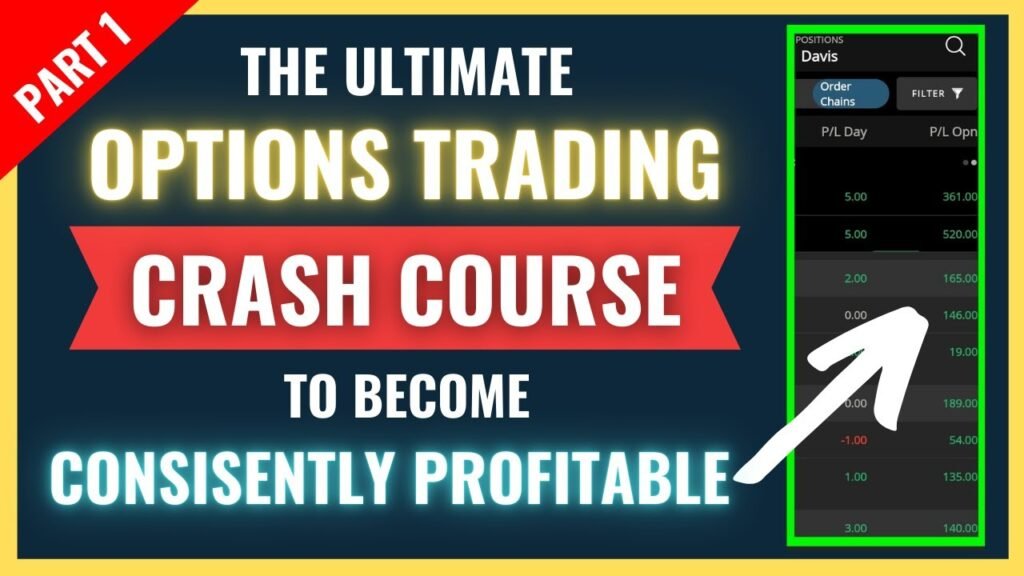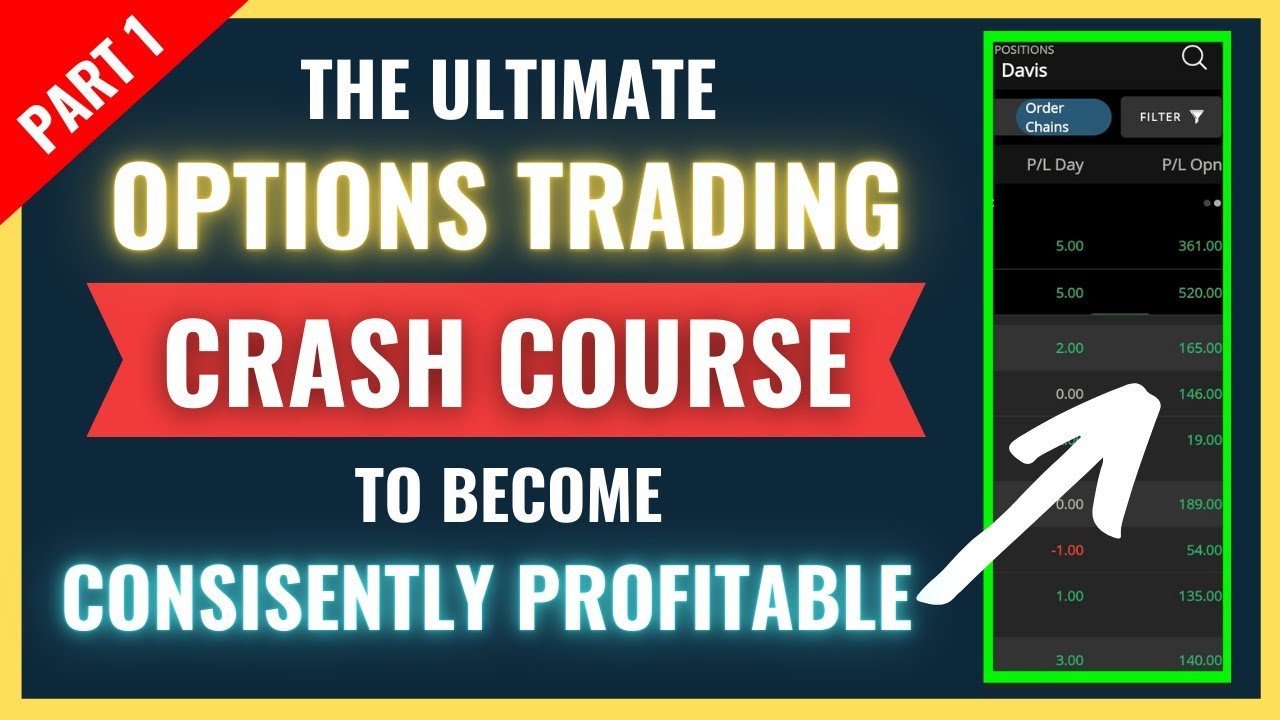“The Ultimate Beginner’s Options Crash Course To Be Consistently Profitable (PART 1)” is a video by Options with Davis that provides essential information and strategies for trading options profitably. The video covers key concepts such as call and put options, strike price, and expiration date. Viewers are encouraged to take notes and repeat the video to grasp the fundamentals of options trading. The video also mentions the availability of a free resource called “The Options Income Blueprint” for those interested in further learning.
In the video, Options with Davis breaks down complex concepts into easily understandable explanations, making it suitable for beginners who want to enter the world of options trading. With a friendly and approachable tone, Davis shares the core essentials and key strategies for consistent profitability. By following the information and techniques provided in the video, viewers can gain the knowledge necessary to successfully trade options and potentially increase their profits.

High-Probability Consistent Income Strategies
In order to be consistently profitable when trading options, it is crucial to understand some key concepts and strategies. These high-probability consistent income strategies can help you maximize your profits and minimize your losses. Let’s dive into the core essentials of these strategies.
Understanding Call and Put Options
Call options give the option buyer the right to buy an underlying stock at a specified price, known as the strike price, within a specified time period before expiration. Put options, on the other hand, give the option buyer the right to sell an underlying stock at the strike price before expiration. By understanding how call and put options work, you can take advantage of different market conditions and profit from your trades.
Understanding Strike Price
The strike price is a crucial component of options trading. It is the price at which the underlying stock can be bought or sold when exercising the option. The strike price affects the profitability of your options trades, as it determines whether the option is in-the-money, at-the-money, or out-of-the-money. Being able to select the right strike price for your trades is essential for maximizing your profits.
Understanding Expiration Date
Every options contract has an expiration date, which is the date by which the option must be exercised before it becomes worthless. Understanding the expiration date is important because it determines the time period within which your options trades can be profitable. It is crucial to select the right expiration date based on your trading strategy and style.
Recurring Profits With The Wheel Strategy
The Wheel Strategy is a popular options trading strategy that allows traders to generate recurring profits. It involves selling covered calls and can be an effective way to generate income. Let’s explore two key aspects of this strategy.
Using the ‘Income Grid’ Wheel Strategy
The Income Grid Wheel Strategy is a systematic approach to generating income from options trading. It involves selling covered calls at different strike prices and expiration dates to create a grid-like structure of income streams. By using this strategy, traders can generate consistent profits while managing their risk effectively.
Selecting Covered Calls
Covered calls are a type of options trade where an investor sells call options on a stock they already own. This strategy allows traders to earn income from the premiums they receive for selling the call options, while still benefiting from any potential upside in the stock price. Selecting the right covered calls is important for maximizing profits and minimizing risk.
Mastering Covered Calls
Covered calls are a versatile options trading strategy that can be mastered with the right knowledge and skill. By employing covered calls effectively, traders can generate consistent income while managing risk. Let’s dive into the ultimate guide for selecting covered calls.
The Ultimate Guide to Selecting Covered Calls
When selecting covered calls, there are several factors to consider. These include the strike price, expiration date, and the premium received from selling the call option. By understanding these factors and analyzing the market conditions, traders can identify the most suitable covered calls for their trading strategies. It is essential to consider the risk-reward profile of each trade and ensure that it aligns with your financial goals.
Option Trading for Beginners
For beginners who are new to options trading, the world of options can be overwhelming. However, with the right guidance and education, beginners can learn the fundamentals of option trading and start their trading journey with confidence. It is important for beginners to understand the basics of call and put options, strike prices, and expiration dates. Additionally, learning about different option trading strategies can help beginners make informed trading decisions.
Option Trading Strategies
Options trading offers a wide range of strategies that traders can utilize to achieve their financial goals. These strategies can be used to generate income, hedge against market volatility, or speculate on price movements. Some popular option trading strategies include bull call spreads, bear put spreads, and iron condors. By understanding and implementing these strategies, traders can effectively manage risk and maximize their profits.
Option Selling Strategies
Option selling strategies, such as selling naked puts or covered calls, can provide traders with an edge in the options market. These strategies involve selling options contracts to generate income from the premiums received. By selecting options with high implied volatility and leveraging the concept of expected move, sellers can take advantage of overstated volatility and generate consistent profits. It is crucial to understand the risks associated with option selling and implement risk management strategies.
Understanding the Concept of Expected Move
The concept of expected move is an important aspect of options trading. It refers to the range within which a stock is likely to trade over a specific time period. The expected move is influenced by factors such as implied volatility, the number of days to expiration, and historical statistics. By understanding the expected move, traders can make informed trading decisions and take advantage of potential price movements.
Important Option Greeks to Consider
Option Greeks are mathematical calculations that help traders understand the risks and potential rewards of an options trade. Delta, Theta, Gamma, and Vega are some of the most important option Greeks to consider. These Greeks measure the sensitivity of an option’s price to various factors, such as changes in the underlying stock price, time decay, market volatility, and changes in implied volatility. By considering these Greeks, traders can better evaluate the potential profitability and risks of their options trades.
Delta
Delta measures the rate of change of an option’s price in relation to changes in the underlying stock price. It indicates how much the option’s price is expected to change for a $1 move in the underlying stock.
Theta
Theta measures the rate of time decay of an option’s price. It indicates how much the option’s value decreases as time passes.
Gamma
Gamma measures the rate of change of an option’s delta in response to changes in the underlying stock price. It indicates the sensitivity of an option’s delta to changes in the stock price.
Vega
Vega measures the sensitivity of an option’s price to changes in implied volatility. It indicates how much the option’s price is expected to change for a 1% change in implied volatility.
Monitoring Delta on a Daily Basis
Delta is a crucial option Greek that traders should monitor on a daily basis. It is a measure of the option’s sensitivity to changes in the underlying stock price. By monitoring delta, traders can assess the risk and potential profitability of their options positions. Delta can help traders determine the likelihood of the option expiring in-the-money and provide valuable insights into potential profits and losses.
Edge in Options Trading
Having an edge in options trading is essential for consistently profitable trading. There are several factors that contribute to gaining an edge in the options market. Let’s explore some of these factors.
Efficient Market Hypothesis
According to the efficient market hypothesis, trading options should result in a net zero, as prices already reflect all available information. However, in reality, there is an edge in options trading due to the overstatement of volatility. By understanding this edge, traders can make informed decisions and identify opportunities for profitable trades.
Edge in Selling Options
Selling options can provide traders with an edge due to receiving more premium than is justified by the actual expected move. By taking advantage of overstated volatility, options sellers can generate consistent income and maximize their profits.
Realized Move vs Expected Move
The realized move refers to the actual movement of a stock’s price, while the expected move refers to the range within which the stock is likely to trade based on market conditions. Often, the realized move is lower than the expected move, especially in high volatility. Traders can take advantage of this difference by trading the expected move and profiting from the edge provided by overstated volatility.
Taking Advantage of the Edge Provided by Overstated Volatility
Historical statistics show that implied volatility tends to overstate actual volatility. This means that prices often stay within the expected move, providing traders with an opportunity to profit by selling options with a higher premium. By capitalizing on this edge, traders can generate consistent income and increase their chances of being profitable.
Options Sellers Have an Edge Over Buyers
Options sellers have an inherent edge over buyers due to receiving more premium than is warranted by the actual move of the market. By utilizing strategies that involve selling options, traders can take advantage of this edge and improve their chances of consistent profitability.
In conclusion, understanding high-probability consistent income strategies is crucial for achieving consistent profitability in options trading. By mastering concepts such as call and put options, strike prices, expiration dates, and important option Greeks, traders can make informed decisions and maximize their profits. Additionally, strategies like the Wheel Strategy and covered calls can provide recurring profits while effectively managing risk. With the right knowledge, skills, and strategies, anyone can become a consistently profitable options trader.
